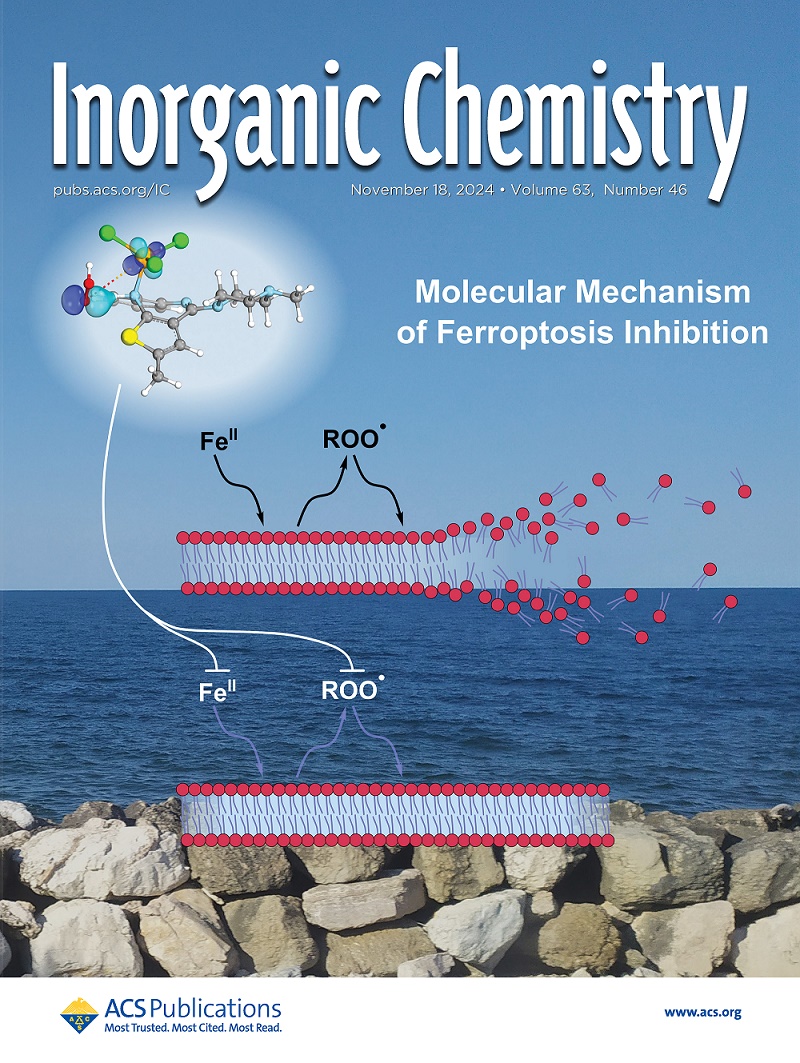近红外发光二极管用Cr3+/Yb3+共掺杂Cs2NaInCl6双钙钛矿
IF 4.3
2区 化学
Q1 CHEMISTRY, INORGANIC & NUCLEAR
引用次数: 0
摘要
近红外(NIR)发光二极管(led)是生物成像、安防监控等领域的核心器件,目前由于缺乏优秀的发光材料而受到发光效率不理想的制约。在这里,我们报道了一种双钙钛矿Cs2NaInCl6,它适合于Cr3+掺杂,并具有广泛的近红外发射。通过Cs2NaInCl6基体中诱导的自俘获激子(STEs)的直接吸收和能量转移(ET), Cr3+可以被激发到4T1(P)、4T1(F)和4T2(F)能级。然后,由于Cr3+的4T2→4A2跃迁,可以实现半最大值全宽度(FWHM)为~ 150nm,跨度为800 ~ 1300nm的宽发射,并且可以实现高达70%的高光致发光量子产率(PLQY)。随后,Yb3+的引入使Cs2NaInCl6:Cr3+、Yb3+在最佳掺杂比下的PLQY比Cs2NaInCl6:Cr3+高76%。最终,基于Cs2NaInCl6:15%Cr3+,15%Yb3+封装的小型化近红外LED器件已制成,在夜视,无迹透视检测和生物成像方面表现出优异的性能。本工作不仅筛选出适合高PLQY掺杂Cr3+的Cs2NaInCl6矩阵,还通过掺杂Yb3+提高了其在近红外LED应用中的发光性能。本文章由计算机程序翻译,如有差异,请以英文原文为准。

Cr3+/Yb3+ Codoped Cs2NaInCl6 Double Perovskites for Near-Infrared Light-Emitting Diodes
Near-infrared (NIR) light-emitting diodes (LEDs) are potential devices that could become the core components in biological imaging, security monitoring, etc., which are currently constrained by suboptimal luminous efficiency due to the absence of excellent luminescent materials. Here, we report a double perovskite Cs2NaInCl6 that is suitable for Cr3+ doping and exhibits broad NIR emission. Through direct absorption and energy transfer (ET) from the self-trapped excitons (STEs) induced in the Cs2NaInCl6 matrix, Cr3+ can be excited to 4T1(P), 4T1(F), and 4T2(F) levels. Then, the broad emission with a full width at half-maximum (FWHM) of ∼150 nm, spanning 800 to 1300 nm, and a high photoluminescence quantum yield (PLQY) of up to 70% can be realized, resulting from the 4T2→4A2 transition of Cr3+. Subsequently, the introduction of Yb3+ endows Cs2NaInCl6:Cr3+,Yb3+ with a higher PLQY of 76% at the optimal doping ratio than Cs2NaInCl6:Cr3+. Ultimately, a miniaturized NIR LED device packaged based on Cs2NaInCl6:15%Cr3+,15%Yb3+ has been fabricated, which demonstrates superior performance for night vision, traceless perspective detection, and biological imaging. This work not only screens out a suitable Cs2NaInCl6 matrix for Cr3+ doping with high PLQY but also promotes its luminescence performance through Yb3+ doping for NIR LED applications.
求助全文
通过发布文献求助,成功后即可免费获取论文全文。
去求助
来源期刊

Inorganic Chemistry
化学-无机化学与核化学
CiteScore
7.60
自引率
13.00%
发文量
1960
审稿时长
1.9 months
期刊介绍:
Inorganic Chemistry publishes fundamental studies in all phases of inorganic chemistry. Coverage includes experimental and theoretical reports on quantitative studies of structure and thermodynamics, kinetics, mechanisms of inorganic reactions, bioinorganic chemistry, and relevant aspects of organometallic chemistry, solid-state phenomena, and chemical bonding theory. Emphasis is placed on the synthesis, structure, thermodynamics, reactivity, spectroscopy, and bonding properties of significant new and known compounds.
 求助内容:
求助内容: 应助结果提醒方式:
应助结果提醒方式:


